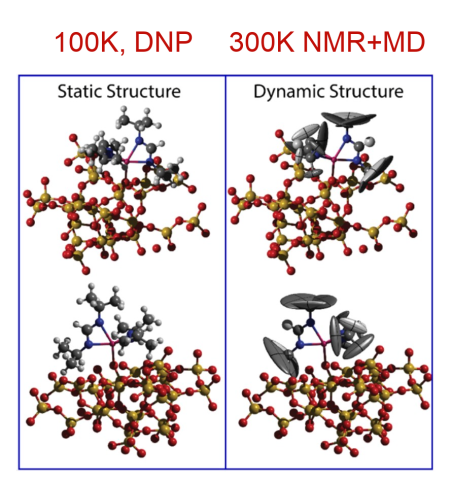Ames Laboratory scientists have experimentally observed the equilibrium dynamics of a scandium single-site catalyst in three-dimensional space through a combination of solid-state NMR, including dynamic nuclear polarization (DNP), and theoretical modeling.
Dynamics are well-known to be a critical component of a successful catalyst given that they enable it to

adapt to changing reaction conditions or to the structure of an incoming reactant. For example, bulk changes in structure, such as oxidation and changes in particle size, have long been a subject of study in catalysis and are readily observed either spectroscopically or microscopically. Dynamic structural changes that occur at equilibrium, however, are not so easily observed. Conformational dynamics, for instance, generally occur at a sub-ns timescale and do not alter the spectroscopic signatures of a material.
Using a combination of DFT modeling and 100 K DNP-enhanced NMR spectroscopy, scientists were able to determine a high-resolution three-dimensional “frozen” structure for the surface-supported Sc site. Room temperature NMR measurements of 1H-13C/45Sc dipolar coupling strengths, as well as the 45Sc quadrupolar coupling strength, were then used to probe the motions of each atomic site. These dynamics could then be mapped onto the aforementioned structure of the catalyst to visualize the motions in three-dimensional space.
The experimentally-determined dynamic averaging of the NMR tensors was compared to that predicted using DFT-based molecular dynamics simulations. Simulations predicted a far more mobile metal complex, suggesting the presence of additional secondary interactions with the surface. Further simulations were used to suggest that these are likely steric in nature and that it may be possible to tune the dynamics of a single-site catalyst by altering the topology of the support surface.
Scientific Achievement
The dynamics of a supported scandium complex have been mapped with unprecedented detail, revealing steric influences that can impact catalytic activity.
Significance and Impact
Conformational dynamics are thought to be essential for catalysis, but conventional methods are largely blind to them. These results pave the way towards the development of dynamics-activity relationships.
Research Details
Observing the three-dimensional dynamics of supported metal complexes.” AL Paterson, D-J Liu, U Kanbur, AD Sadow, FA Perras, Inorg. Chem. Frontiers 2021, 8, 1416-1431.
